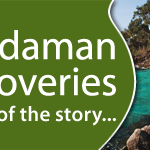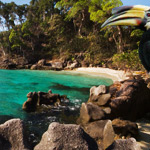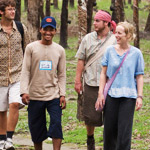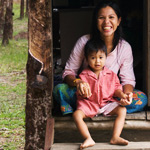Andaman Discoveries Blog
Thursday, December 1, 2011
A visit to the last refuge of the Water Lily
 P’Somsakthe environment-specialist from IUCN (International Union for Conservation of Nature) took the biggest part of the AD crew Nat, Nia and Simon on a field-trip to see an endemic Water lily species 15 minutes away from Kuraburi Center. It grows in a small stream with constantly running water but the flow shouldn’t to strong. Also it’s very clear and fresh water because the flower just grows under these conditions.
P’Somsakthe environment-specialist from IUCN (International Union for Conservation of Nature) took the biggest part of the AD crew Nat, Nia and Simon on a field-trip to see an endemic Water lily species 15 minutes away from Kuraburi Center. It grows in a small stream with constantly running water but the flow shouldn’t to strong. Also it’s very clear and fresh water because the flower just grows under these conditions.
The plant is commonly know as „Yah Chong“, its scientific name is crinum thaianum. The place is one of the last places on the world where this plant grows and protected by an old thai-farmer. When the water lily started to grow on his terrain. First he had no idea which treasure he defended and got intruders and plant theifs on the run with his machete.
A nursery and rehabilitation programe led by P’Somsak, tries to protect and replant the flower in its natural habitat. For that he collects the seeds, heals it and gives it a new chance. Indirect actions are stopping the erosion through protecting the reed habitat, which has influence on the water lily habitat. Another helpful factor are youth groups the were formed up many years ago. They test on regular basis the water quality and the plants habitat.
But what can you do, when a big land excavator comes? Dredging causes in this areas a lot of problems and is one reason why the beautiful water lily is even more in danger nowadays. Thanks to P’Somsak and his team the water lily still has a chance and can be brought back into wildlife.
Recommendations: + Water Lilies are collected for commercial purposes in large numbers, especially in the dry season (January-April). To promote conservation of this endemic species, government agencies, local authorities and local people should coordinate their activities within the context of a long term management plan.
+ Water Lilies are collected for commercial purposes in large numbers, especially in the dry season (January-April). To promote conservation of this endemic species, government agencies, local authorities and local people should coordinate their activities within the context of a long term management plan.
+ Klong Bang Pong should be conserved urgently because it has the highest concentration of Water Lilies in Phang Nga province after Klong Na Ca. The canal is still very healthy, clean and clear.
+ In the past local communities in Klong Nui and Klong Ta Put tried banning Water Lily collection with limited success. It is recommended to reengage these processes to promote successful management in Water Lily conservation.
+ In the past, Klong Tumnang, Klong Bang Pow Moo and Klong Kamnanhad had a high density of Water Lilies and still have good conditions to support Water Lily rehabilitation. These are good areas to introduce Water Lily breeding.
+ Almost all of the other canals are in private land, so it is recommended to work through local leaders to conserve the species.
+ Klong Na Ca is an excellent case study of Water Lily conservation and organizations should use this area as a learning centre.
Subscribe to Comments [Atom]






